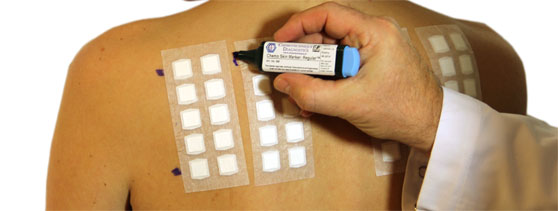 A patch test is a method used to determine whether a specific substance causes allergic inflammation of a patient's skin. Any individual suspected of having allergic contact dermatitis and/or atopic dermatitis needs patch testing.Patch testing helps identify which substances may be causing a delayed-type allergic reaction in a patient, and may identify allergens not identified by blood testing or skin prick testing. It is intended to produce a local allergic reaction on a small area of the patient's back, where the diluted chemicals were planted. The chemicals included in the patch test kit are the offenders in approximately 85–90 percent of contact allergic eczema, and include chemicals present in metals (e.g., nickel), rubber, leather, formaldehyde, lanolin, fragrance, toiletries, hair dyes, medicine, pharmaceutical items, food, drink, preservative, and other additives.
A patch test is a method used to determine whether a specific substance causes allergic inflammation of a patient's skin. Any individual suspected of having allergic contact dermatitis and/or atopic dermatitis needs patch testing.Patch testing helps identify which substances may be causing a delayed-type allergic reaction in a patient, and may identify allergens not identified by blood testing or skin prick testing. It is intended to produce a local allergic reaction on a small area of the patient's back, where the diluted chemicals were planted. The chemicals included in the patch test kit are the offenders in approximately 85–90 percent of contact allergic eczema, and include chemicals present in metals (e.g., nickel), rubber, leather, formaldehyde, lanolin, fragrance, toiletries, hair dyes, medicine, pharmaceutical items, food, drink, preservative, and other additives.
What to Avoid
Avoid taking oral prednisone or other immunosuppressive medications for at least a week prior to testing. Steroid inhalers are OK to use. Avoid sunlight/sunburn for at least a week on the back, as this may suppress positive reactions. Antihistamines such as diphenhydramine (Benadryl) or cetirizine (Zyrtec) are permissible prior to and during testing.
Time Involved
Application of the patch tests will take about half an hour, though many times the overall appointment time will be longer as the provider will take an extensive history. Tiny quantities of 25 to ~150 materials (allergens) in individual square plastic or round aluminum chambers are applied to the upper back. They are kept in place with special hypoallergenic adhesive tape. The patches stay in place undisturbed for at least 48 hours. Getting the back wet during patch testing should be avoided (no shower). Vigorous exercise or stretching may disrupt the test.
Second Appointment
At the second appointment, usually 48 hours later, the patches are removed. Sometimes additional patches are applied. The back is marked with an indelible black felt tip pen or other suitable marker to identify the test sites, and a preliminary reading is done. These marks must be visible at the third appointment, usually 24–48 hours later (72–96 hours after application). In some cases, a reading at 7 days may be requested, especially if a special metal series is tested.
